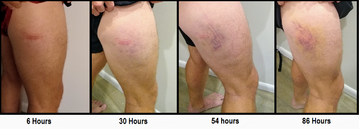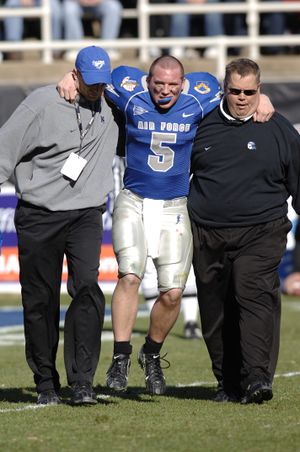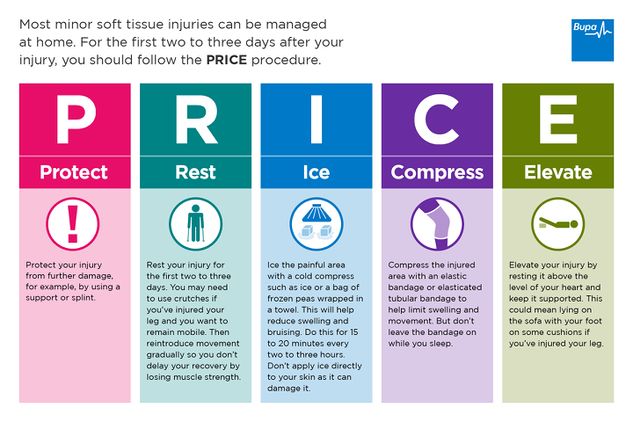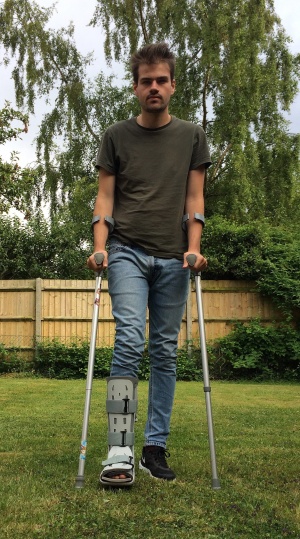Soft Tissue Injuries: Difference between revisions
Abbey Wright (talk | contribs) No edit summary |
No edit summary |
||
| (19 intermediate revisions by 4 users not shown) | |||
| Line 1: | Line 1: | ||
<div class="editorbox"> '''Original Editor '''- [[User:Abbey Wright|Abbey Wright] < | <div class="editorbox"> '''Original Editor '''- [[User:Abbey Wright|Abbey Wright]] | ||
'Top Contributors''' - {{Special:Contributors/{{FULLPAGENAME}}}}'''</div> | |||
== Introduction == | == Introduction == | ||
Acute soft tissue injuries have classically been managed through various acronyms the most well known being [[RICE]] and [[POLICE Principle|POLICE]]. These acronyms have been around for many years and focus primarily on the acute stages of a soft tissue injury, | Soft-tissue injuries rehabilitation can be quite complicated. Different acronyms have been used throughout the years to guide their management, which evolved from ICE to [[RICE]] and PRICE to [[POLICE Principle|POLICE]]. However, these acronyms mainly focus on the acute stage of the injury, leaving aside the subacute and chronic stages of tissue healing.<ref>Dubois B, Esculier JF. Soft-tissue injuries simply need PEACE and LOVE. Br J Sports Med. 2020;54(2):72–3. </ref>[[File:Hematoma development.png|right|frameless|359x359px|–––]]Acute soft tissue injuries have classically been managed through various acronyms the most well known being [[RICE]] and [[POLICE Principle|POLICE]]. | ||
* These acronyms have been around for many years and focus primarily on the acute stages of a soft tissue injury, research has progressed making these acronyms outdated and inaccurate. eg the use of [[NSAIDs in the Management of Rheumatoid Arthritis|NSAID]]<nowiki/>s in an acute injury can actually be detrimental to the recovery and healing process.<ref name=":1">Dubois B, Esculier J | |||
[https://bjsm.bmj.com/content/54/2/72 Soft-tissue injuries simply need PEACE and LOVE] | [https://bjsm.bmj.com/content/54/2/72 Soft-tissue injuries simply need PEACE and LOVE] | ||
| Line 11: | Line 13: | ||
</ref> | </ref> | ||
* Most of the research uses an acute lateral ankle sprain as the clinical example so it can be helpful to think of applying these principles to a patient with that type of injury. | |||
Image 1: Hematoma development. | |||
== | New research promotes new acronyms to apply to the acute and sub-acute stages of an injury and promote [[Load Management|loading]] and activity. | ||
== PEACE and LOVE == | |||
See link [[Peace and Love Principle|PEACE and LOVE]] | |||
= | # In the acute stage of an injury apply PEACE.<ref name=":1" /> '''P: protect E: elevate A: avoid anti-inflammatories/ice C: compression E: educate''' | ||
# In the sub-acute stage LOVE should be used '''L: [[Load Management|load]] O: optimism V: vascularisation E: [[Therapeutic Exercise|exercise]]''' | |||
I: ice | == History of soft tissue management == | ||
[[File:Knee injury football.jpg|right|frameless]] | |||
ICE: Initially soft tissue injuries were managed through ICE. '''I: ice C: compression E: elevation''' | |||
* Focused heavily on the [[Cryotherapy Guidelines|cryotherapy]]. We now know that ice can potentially cause slower healing times as it disrupts normal [[Inflammation Acute and Chronic|inflammation]] and revascularisation. There is evidence to show that ice is useful for [[Pain Medications|analgesia]]. More evidence is required to fully understand the physiological processes that occur when ice is used in an acute injury. <ref name=":0">van den Bekerom MP, Struijs PA, Blankevoort L, Welling L, Van Dijk CN, Kerkhoffs GM. [https://www.ncbi.nlm.nih.gov/pmc/articles/PMC3396304/ What is the evidence for rest, ice, compression, and elevation therapy in the treatment of ankle sprains in adults?]. Journal of athletic training. 2012 Jul;47(4):435-43.</ref> | |||
* Compression and Elevation are also advised in the ICE acronym. These are mainly anecdotal in recommendation and there is no set advice regarding duration of compression or elevation. Elevation has been show to help reduce inflammation however, this inflammation is normal and is useful in the normal [[Soft Tissue Healing|process of healing]]. <ref name=":0" /> | |||
We now know that ice can potentially cause slower healing times as it disrupts normal inflammation and revascularisation. | |||
Compression and Elevation are also advised in the ICE acronym. These are mainly anecdotal in recommendation and there is no set advice regarding duration of compression or elevation. Elevation has been show to help reduce inflammation however, this inflammation is normal and is useful in the normal [[Soft Tissue Healing|process of healing]]. <ref name=":0" /> | |||
=== RICE and PRICE === | === RICE and PRICE === | ||
[[RICE]] and PRICE were then recommended as an addition to ICE. | [[File:PRICE picture.jpg|633x633px|alt=|right|frameless]][[RICE]] and PRICE were then recommended as an addition to ICE. | ||
P: | # Long periods of rest and protection can be detrimental to recovery, leading to muscle wastage and altered [[Biomechanics|bio-mechanics]] of the limb.<ref>Bleakley CM, Glasgow P, MacAuley DC. [https://bjsm.bmj.com/content/46/4/220 PRICE needs updating, should we call the POLICE?]British Journal of Sports Medicine 2012;46:220-221.</ref> However, following an acute injury rest and protection of the limb is still recommended in the acute stages. | ||
[[ | # Early mobilisation and [[weight bearing]] has been shown to accelerate recovery in acute soft tissue injury<ref>Bleakley CM, O’Connor SR, Tully MA, Rocke LG, MacAuley DC, Bradbury I, Keegan S, McDonough SM. [https://www.bmj.com/content/340/bmj.c1964?ijkey=18b9a5b8a9d5b4191f0f50ac7d7b4f4d05256d99&keytype2=tf_ipsecsha Effect of accelerated rehabilitation on function after ankle sprain]: randomised controlled trial. Bmj. 2010 May 10;340.</ref>. | ||
=== POLICE === | |||
POLICE is an acronym that stands for protection, optimal loading, ice compression, and elevation. It promotes and guides safe and effective loading in acute soft tissue injury management. POLICE was introduced to promote loading in the affected area and prevent long term immobilisation. See [[POLICE Principle|POLICE]] link | |||
POLICE was introduced to promote loading in the affected area and prevent long term immobilisation. | |||
== Clinical bottom line == | == Clinical bottom line == | ||
[[File:2448px-Teenage boy on crutches with walking boot.jpg|right|frameless]] | |||
As research has progressed the need to educate and promote loading has become apparent in order to recover fully from an injury. As physiotherapists this is not new information, however, the need for PEACE and LOVE to be more publicized should be priority in physiotherapy clinics. | As research has progressed the need to educate and promote loading has become apparent in order to recover fully from an injury. As physiotherapists this is not new information, however, the need for PEACE and LOVE to be more publicized should be priority in physiotherapy clinics. | ||
The advice to "avoid anti-inflammatories" has been contradictory although the evidence supports this in the acute stages of injury. <ref>Vuurberg G, Hoorntje A, Wink LM, Van Der Doelen BF, Van Den Bekerom MP, Dekker R, Van Dijk CN, Krips R, Loogman MC, Ridderikhof ML, Smithuis FF. [https://pubmed.ncbi.nlm.nih.gov/29514819/ Diagnosis, treatment and prevention of ankle sprains: update of an evidence-based clinical guideline]. British journal of sports medicine. 2018 Aug 1;52(15):956-.</ref> <br> | * The advice to "avoid anti-inflammatories" has been contradictory although the evidence supports this in the acute stages of injury. <ref>Vuurberg G, Hoorntje A, Wink LM, Van Der Doelen BF, Van Den Bekerom MP, Dekker R, Van Dijk CN, Krips R, Loogman MC, Ridderikhof ML, Smithuis FF. [https://pubmed.ncbi.nlm.nih.gov/29514819/ Diagnosis, treatment and prevention of ankle sprains: update of an evidence-based clinical guideline]. British journal of sports medicine. 2018 Aug 1;52(15):956-.</ref> | ||
* PEACE and LOVE is useful for clinicians and patients as it does not only focus on the immediate short term injury but in fact promotes rehabilitation and exercise. <br> | |||
== Resources == | == Resources == | ||
| Line 64: | Line 51: | ||
[https://www.physiosinsport.org/media/wysiwyg/ACPSM_Physio_Price_A4.pdf PRICE principle] | [https://www.physiosinsport.org/media/wysiwyg/ACPSM_Physio_Price_A4.pdf PRICE principle] | ||
[https://www.youtube.com/watch?v=HGTabgG7GIU PEACE and LOVE explained] | [https://www.youtube.com/watch?v=HGTabgG7GIU PEACE and LOVE explained] | ||
[https://www.physiospot.com/research/the-management-of-soft-tissue-injuries-a-peace-and-love-approach/?utm_source=rss&utm_medium=rss&utm_campaign=the-management-of-soft-tissue-injuries-a-peace-and-love-approach PEACE and LOVE in our clinics] | |||
[https://physio-pedia.com/Lateral_Ligament_Injury_of_the_Ankle Lateral ankle injury] | |||
[[Soft Tissue Healing|Soft tissue healing]] | |||
== References == | == References == | ||
<references /> | <references /> | ||
[[Category:Musculoskeletal/Orthopaedics]] | |||
[[Category:Acute Care]] | |||
[[Category:Interventions]] | |||
[[Category:Ligaments]] | |||
[[Category:Muscle strain]] | |||
[[Category:Rehabilitation Protocols]] | |||
Latest revision as of 07:33, 18 January 2024
Introduction[edit | edit source]
Soft-tissue injuries rehabilitation can be quite complicated. Different acronyms have been used throughout the years to guide their management, which evolved from ICE to RICE and PRICE to POLICE. However, these acronyms mainly focus on the acute stage of the injury, leaving aside the subacute and chronic stages of tissue healing.[1]
Acute soft tissue injuries have classically been managed through various acronyms the most well known being RICE and POLICE.
- These acronyms have been around for many years and focus primarily on the acute stages of a soft tissue injury, research has progressed making these acronyms outdated and inaccurate. eg the use of NSAIDs in an acute injury can actually be detrimental to the recovery and healing process.[2]
- Most of the research uses an acute lateral ankle sprain as the clinical example so it can be helpful to think of applying these principles to a patient with that type of injury.
Image 1: Hematoma development.
New research promotes new acronyms to apply to the acute and sub-acute stages of an injury and promote loading and activity.
PEACE and LOVE[edit | edit source]
See link PEACE and LOVE
- In the acute stage of an injury apply PEACE.[2] P: protect E: elevate A: avoid anti-inflammatories/ice C: compression E: educate
- In the sub-acute stage LOVE should be used L: load O: optimism V: vascularisation E: exercise
History of soft tissue management[edit | edit source]
ICE: Initially soft tissue injuries were managed through ICE. I: ice C: compression E: elevation
- Focused heavily on the cryotherapy. We now know that ice can potentially cause slower healing times as it disrupts normal inflammation and revascularisation. There is evidence to show that ice is useful for analgesia. More evidence is required to fully understand the physiological processes that occur when ice is used in an acute injury. [3]
- Compression and Elevation are also advised in the ICE acronym. These are mainly anecdotal in recommendation and there is no set advice regarding duration of compression or elevation. Elevation has been show to help reduce inflammation however, this inflammation is normal and is useful in the normal process of healing. [3]
RICE and PRICE[edit | edit source]
RICE and PRICE were then recommended as an addition to ICE.
- Long periods of rest and protection can be detrimental to recovery, leading to muscle wastage and altered bio-mechanics of the limb.[4] However, following an acute injury rest and protection of the limb is still recommended in the acute stages.
- Early mobilisation and weight bearing has been shown to accelerate recovery in acute soft tissue injury[5].
POLICE[edit | edit source]
POLICE is an acronym that stands for protection, optimal loading, ice compression, and elevation. It promotes and guides safe and effective loading in acute soft tissue injury management. POLICE was introduced to promote loading in the affected area and prevent long term immobilisation. See POLICE link
Clinical bottom line[edit | edit source]
As research has progressed the need to educate and promote loading has become apparent in order to recover fully from an injury. As physiotherapists this is not new information, however, the need for PEACE and LOVE to be more publicized should be priority in physiotherapy clinics.
- The advice to "avoid anti-inflammatories" has been contradictory although the evidence supports this in the acute stages of injury. [6]
- PEACE and LOVE is useful for clinicians and patients as it does not only focus on the immediate short term injury but in fact promotes rehabilitation and exercise.
Resources[edit | edit source]
References[edit | edit source]
- ↑ Dubois B, Esculier JF. Soft-tissue injuries simply need PEACE and LOVE. Br J Sports Med. 2020;54(2):72–3.
- ↑ 2.0 2.1 Dubois B, Esculier J Soft-tissue injuries simply need PEACE and LOVE British Journal of Sports Medicine 2020;54:72-73
- ↑ 3.0 3.1 van den Bekerom MP, Struijs PA, Blankevoort L, Welling L, Van Dijk CN, Kerkhoffs GM. What is the evidence for rest, ice, compression, and elevation therapy in the treatment of ankle sprains in adults?. Journal of athletic training. 2012 Jul;47(4):435-43.
- ↑ Bleakley CM, Glasgow P, MacAuley DC. PRICE needs updating, should we call the POLICE?British Journal of Sports Medicine 2012;46:220-221.
- ↑ Bleakley CM, O’Connor SR, Tully MA, Rocke LG, MacAuley DC, Bradbury I, Keegan S, McDonough SM. Effect of accelerated rehabilitation on function after ankle sprain: randomised controlled trial. Bmj. 2010 May 10;340.
- ↑ Vuurberg G, Hoorntje A, Wink LM, Van Der Doelen BF, Van Den Bekerom MP, Dekker R, Van Dijk CN, Krips R, Loogman MC, Ridderikhof ML, Smithuis FF. Diagnosis, treatment and prevention of ankle sprains: update of an evidence-based clinical guideline. British journal of sports medicine. 2018 Aug 1;52(15):956-.










